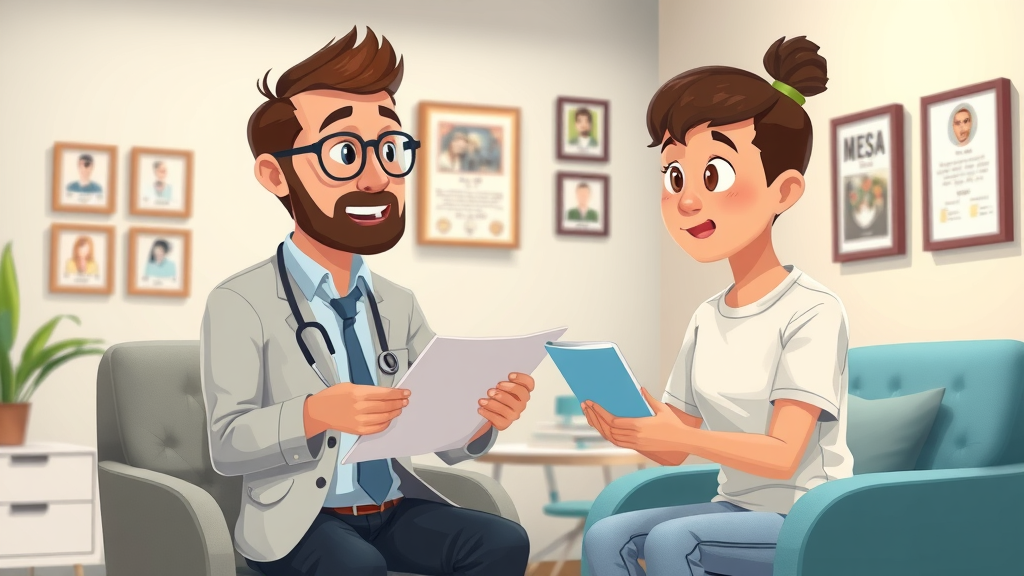Did you know that nearly 1 in 5 teens experience a diagnosable behavioral health disorder, yet most never receive the therapy they truly need? Ignoring the early warning signs in your young adult can result in missed opportunities for healing and growth. Teen behavior therapy isn’t just another option—it can be the turning point that brings lasting change and stability to a teenager’s life. In this comprehensive guide, you’ll discover the essentials of behavioral therapy for teens, learn why timely help matters, and get expert strategies for taking action before costly mistakes are made.
Startling Facts About Teen Behavior Therapy
"Did you know nearly 1 in 5 teens experience a diagnosable behavioral health disorder, yet most never receive the therapy they truly need?"
Teen behavior therapy is often overlooked, yet its urgency cannot be overstated. Recent studies on adolescent mental health have highlighted that up to 20% of young adults deal with behavioral health disorders, ranging from intense mood swings to persistent negative thought patterns. Shockingly, a majority of these teens never access the behavioral therapy or coping skills that could profoundly change their developmental course. The stigma of mental health, combined with misconceptions about behavioral therapy, frequently prevents families from seeking timely intervention. As a result, the window for early healing and effective long-term outcomes may close faster than most realize. Understanding these facts is crucial for parents, educators, and anyone responsible for young adult wellness.
This knowledge serves as a call to action: delaying essential behavioral therapy can result in entrenched thought patterns, ongoing mood swings, and reduced resilience in adulthood. With modern therapies such as dialectical behavior therapy and cognitive behavioral therapy, teens can learn to manage their emotions, build coping strategies, and positively reshape their lives. The following sections reveal practical guidance and expert-backed insight into harnessing behavioral therapy for lasting success.

What You'll Learn About Teen Behavior Therapy
- The essentials of teen behavior therapy and why timely intervention matters
- Overview of major therapy types: dialectical behavior therapy, cognitive behavioral therapy, family therapy, and more
- How to recognize behavioral issues and negative thought patterns in young adults
- Key steps in selecting and supporting the best behavioral therapy for your teenager
Understanding Teen Behavior Therapy: Definitions and Misconceptions
What Is Teen Behavior Therapy?

Teen behavior therapy is a specialized approach designed to help adolescents and young adults confront and manage mental health disorders that manifest as difficult behaviors or emotional responses. At its core, behavior therapy helps teens learn healthy ways to cope with mood swings, negative thought patterns, and interpersonal conflicts. These therapy sessions with trained professionals create a safe environment where teens discover coping skills and strategies tailored to their unique situations. Sessions might involve identifying triggers, restructuring harmful thoughts, and developing ways to manage their emotions under stress.
Behavioral therapy draws from evidence-based approaches like cognitive behavioral therapy (CBT), which targets negative thought patterns, and dialectical behavior therapy (DBT), which is particularly effective for adolescents dealing with intense emotions and impulsivity. Family therapy also plays a crucial role, engaging family members in the healing process to support teens’ emotional growth and consistent practice of new skills. Ultimately, teen behavior therapy focuses on the specific mental health needs of adolescents, providing them with practical, lifelong tools for overcoming emotional and behavioral health challenges.
Common Myths Surrounding Behavior Therapy for Young Adults
Despite growing awareness about adolescent mental health, several myths still hinder families from accessing behavioral therapy. A common misconception is that teens must reach a crisis point—exhibiting severe mood swings or risky behavior—before starting therapy. In truth, early intervention is proven to be more effective, helping to prevent negative thought patterns from taking root and guiding young adults toward healthier paths. Another myth is that behavioral therapy means something is “wrong” with a teen, when in fact therapy provides teens and their families with ways to manage normal developmental challenges.
Other misunderstandings involve thinking that therapy is only about talking, or that it will not “work” unless a teen is fully cooperative. Behavioral therapy equips adolescents with coping skills and new ways to deal with intense emotions, regardless of initial resistance. Furthermore, some assume that CBT or DBT are “one-size-fits-all” approaches; however, qualified therapists always tailor sessions to the individual needs and thought patterns of each teen. Identifying and confronting these myths allows parents, teens, and family members to pursue evidence-based support without unnecessary delay.
The Importance of Early Intervention in Teen Behavior Therapy
How Early Behavioral Therapy Impacts Teen Mental Health
Early access to teen behavior therapy has profound effects on adolescent mental health. When mood swings, negative thought patterns, or intense emotions are recognized and addressed early, teenagers learn to develop healthy coping skills before maladaptive behaviors become entrenched. Behavioral therapy introduces practical strategies that help teens manage their stress, anxiety, and interpersonal difficulties, all of which can escalate if left untreated. This timely intervention not only helps teens and their families navigate present challenges but also lays the foundation for lifelong emotional wellness.
The impact of starting behavioral therapy early can be seen in improved academic performance, enhanced relationships with family members, and greater resilience during stressful periods. Young adults are guided toward building a positive self-image, developing emotional regulation, and fostering healthy thought patterns that protect against mental health disorders in later life. By investing in early intervention, parents and teens can dramatically reduce the risk of chronic mental health issues and promote a future marked by well-being and stability.
Long-Term Outcomes for Young Adults
Teens who engage in behavioral therapy early tend to experience better long-term results well into adulthood. Research indicates that young adults with a history of evidence-based therapy—like cognitive behavioral therapy and dialectical behavior therapy—show significantly lower rates of recurring anxiety, depression, and substance use disorders. Therapy provides not just immediate relief from intense emotions or mood swings, but equips teens with coping strategies that strengthen over time, enabling them to manage stress and conflict as they move into independent adulthood.
Furthermore, ongoing behavioral therapy enhances self-awareness, emotional intelligence, and problem-solving skills among adolescents. This growth prepares them for the complex decisions and stressors they will encounter as young adults, reducing the likelihood of falling back into negative thought patterns or maladaptive habits. With the right early support, the benefits extend to academic success, career achievement, and fulfilling relationships—making behavioral therapy a vital investment in every teen's future.
Types of Teen Behavior Therapy
Dialectical Behavior Therapy (DBT) for Teens

Dialectical behavior therapy (DBT) is an evidence-based approach that helps teens struggling with intense emotions and frequent mood swings. Unlike traditional talk therapy, DBT emphasizes the development of specific coping skills—mindfulness, distress tolerance, emotion regulation, and interpersonal effectiveness. For young adults, these skills provide concrete strategies for managing emotional outbursts, unstable relationships, or impulses that can lead to risky behaviors.
What sets DBT apart is its structured format: group skills training sessions, individual therapy, and support outside sessions (like coaching calls or family involvement). Teens learn to identify and correct negative thought patterns while gaining tools to tolerate and survive distress without resorting to unhealthy coping mechanisms. DBT’s success with teen behavior therapy has made it one of the most recommended options for adolescents with self-harming tendencies, suicidal ideation, or severe behavioral health challenges. By addressing both emotional and practical life skills, DBT empowers teens for sustainable recovery.
Cognitive Behavioral Therapy (CBT) and Coping Skills
Cognitive behavioral therapy (CBT) is widely used in teen behavior therapy to help adolescents recognize and transform negative thought patterns into positive, productive behaviors. CBT is especially effective for teens experiencing anxiety, depression, or problematic coping strategies. During therapy sessions, therapists guide teens in uncovering how their beliefs and thoughts influence their feelings and actions. Once these patterns are identified, CBT helps teens develop and repeatedly practice healthier responses to stressful situations.
CBT helps teens by encouraging them to challenge irrational fears, replace self-defeating thoughts, and adopt healthy ways to manage anxiety and mood swings. Teens learn that they are not powerless over their internal experiences and develop long-lasting coping skills for academic, social, and family challenges. Evidence shows that cognitive behavioral therapy equips young adults with resources they need to navigate difficult emotions, relationships, and even mental health crises more confidently and independently.
Family Therapy and its Role in Addressing Mood Swings and Thought Patterns
Family therapy brings together teens and their family members to address the environmental and relational factors influencing a teen’s mental health. Many behavioral health issues, such as recurring mood swings, negative thought patterns, or impulsive behavior, can be worsened by dysfunctional family dynamics. Family therapy provides a structured environment for improving communication, resolving conflict, and building a network of support that reinforces progress outside of individual therapy sessions.
Through family therapy, parents and siblings learn how to recognize patterns in their own behavior that may contribute to a teen’s emotional struggles. The therapist guides families in rebuilding trust and teaching all participants healthy ways to manage conflict and stress. Effective family therapy ensures that the gains teens achieve in individual sessions are reinforced at home, leading to stronger relationships and a more stable foundation for the teen’s ongoing recovery.
Other Recognized Behavioral Therapy Methods for Young Adults
In addition to DBT, CBT, and family therapy, there are several other behavioral therapy approaches relevant to young adults. Acceptance and Commitment Therapy (ACT) helps teens accept difficult thoughts and feelings without judgment and commit to personal growth aligned with their values. Interpersonal Therapy (IPT) focuses on developing healthy relationship skills and resolving conflicts that trigger emotional distress. There’s also Art or Play Therapy, especially useful for younger teens or those who struggle to express themselves verbally.
Each approach is selected based on the teen’s psychological profile, unique challenges, and strengths. For some, a combination of therapies—known as an integrated treatment plan—offers the best chances for sustained mental health. It’s essential that older adolescents and young adults receive therapy tailored to their specific needs, goals, and developmental stage. Consulting with experienced behavioral health professionals ensures the choice of therapy methods is both evidence-based and individualized.
| Therapy Type | Key Focus Areas | Best For | Session Format |
|---|---|---|---|
| Dialectical Behavior Therapy (DBT) | Emotion regulation, distress tolerance, coping skills | Teens with intense mood swings, self-harm, or impulsivity | Group & individual sessions, family involvement |
| Cognitive Behavioral Therapy (CBT) | Challenging negative thought patterns, coping strategies | Anxiety, depression, behavioral issues | Individual sessions, occasionally family inclusion |
| Family Therapy | Family communication, support systems, conflict resolution | Teens & their families, disruptive home environments | Group sessions with family members |
| Acceptance and Commitment Therapy (ACT) | Mindfulness, values-driven action, acceptance of feelings | Teens struggling with avoidance and anxiety | Individual and group sessions |
| Interpersonal Therapy (IPT) | Relationship skills, emotional support | Social anxiety, grief, interpersonal conflict | Individual or occasional group sessions |
Recognizing When Your Teen Needs Behavior Therapy
Red Flags: Mood Swings, Negative Thought Patterns, and More

Recognizing when a teen might need behavior therapy can be challenging, especially as mood swings and changes in behavior are often considered part of growing up. However, certain red flags—like persistent negative thought patterns, withdrawal from friends and family, dramatic drops in academic performance, and frequent emotional outbursts—signal a deeper need for support. Teens who display self-harm, talk about hopelessness, or experiment with risky behaviors require immediate assessment by mental health professionals.
Behavior therapy becomes essential when these signs interfere with daily functioning and family relationships. The earlier these issues are addressed, the more effective behavioral therapy can be at reversing negative trends and equipping young adults with healthy coping strategies. Parents and guardians should remain attentive to sudden or sustained changes in a teen’s mood, demeanor, or routines; proactively seeking professional support ensures no warning sign goes unaddressed.
The Role of Parents and Guardians in Early Recognition
Parents and guardians are often the first to notice subtle shifts in their teen’s mood, behavior, or thought patterns. Their active engagement is vital in recognizing when emotional distress exceeds what’s expected for a young adult’s developmental stage. Open communication, non-judgmental listening, and willingness to discuss mental health without stigma all help in building trust with teens. Keeping track of patterns—such as recurring mood swings, anxious behaviors, or expressions of negative self-worth—enables early intervention through behavioral therapy.
Family members should seek guidance from mental health professionals at the first sign of trouble, rather than waiting for a crisis to escalate. A strong partnership between families and care providers increases the likelihood of a successful therapy outcome, as consistent support reinforces the skills and positive habits built during therapy sessions. Remember, being proactive rather than reactive is the smartest way to transform behavioral challenges into opportunities for emotional growth.
- Frequent mood swings or unpredictable emotional reactions
- Withdrawal from family members, friends, or usual activities
- Consistent negative thought patterns or hopelessness
- Significant decline in grades or school engagement
- Self-harm, talk of suicide, or risky behaviors
- Unexplained physical complaints (headaches, stomachaches)
- Sudden changes in sleeping or eating habits
Choosing the Right Teen Behavior Therapy for Your Child
Assessing Individual Needs: Thought Patterns and Coping Strategies

Choosing the most effective teen behavior therapy begins with a comprehensive assessment of your child’s unique thought patterns, coping skills, and mental health history. Effective assessment includes not only a diagnosis but also an exploration of individual strengths, triggers, and previous strategies used in stressful situations. Mental health professionals will often use structured interviews, observation, and standardized questionnaires to gather information and develop a treatment plan tailored to the teen’s needs.
It’s important to involve both the teen and their family members in this process; understanding the teen’s perspective sheds light on how they currently manage their emotions and what coping strategies they are most likely to embrace. This collaborative approach ensures therapy addresses the root causes—whether it’s negative thought patterns, mood swings, or unresolved trauma. Early identification and individualized planning help make therapy sessions more productive and supportive for young adults on their path to healing.
Working With Mental Health Professionals
The role of the mental health professional is central to selecting, implementing, and monitoring your teen’s behavior therapy plan. Experienced therapists take time to build rapport with adolescents, fostering a sense of safety and openness necessary for meaningful progress. Parents and teens should expect to work collaboratively with clinicians to set goals, track progress, and adjust strategies when needed. Family participation is often encouraged—especially with approaches like family therapy and DBT—because consistency in support can dramatically enhance therapy outcomes.
Don’t hesitate to ask providers about their experience, methodologies, and philosophy on adolescent mental health. Working together, families and mental health professionals offer a unified front that bolsters the teen’s confidence and accountability, ensuring therapy not only addresses symptoms but also builds life-long skills for emotional resilience. Remember, therapy works best when teens and their families are actively involved in the process from start to finish.
Questions to Ask Before Starting Behavioral Therapy
Before selecting a behavioral therapist for your teen, it’s critical to make informed decisions. Here are the top questions to ask:
- What is your experience in working with adolescents and young adults facing behavioral health challenges?
- What types of therapy do you use most often, and how will you determine the best approach for my teen?
- Do you involve family members in therapy sessions? What is the structure and expected level of participation?
- How do you measure progress and adapt your approach if my teen isn’t responding?
- What strategies are in place for helping teens manage their emotions and avoid negative thought patterns between sessions?
"Tailoring therapy to the unique needs of each young adult is critical for lasting success."
Maximizing the Benefits of Teen Behavior Therapy
Encouraging Coping Skills & Positive Thought Patterns
For teen behavior therapy to unlock its full potential, daily reinforcement of coping skills and positive thought patterns is essential. Teens often encounter triggers and stressful events between therapy sessions—whether at school, at home, or with friends—which can challenge even the best-learned strategies. Consistently practicing new skills (like mindfulness, reframing negative thoughts, or regulated breathing) ensures these techniques become automatic responses during moments of stress or overwhelm. Parents can further support by encouraging open communication, celebrating small victories, and modeling healthy coping behaviors.
The best behavioral therapy outcomes are achieved when teens are reminded that setbacks are part of growth, not failures. Encouragement, regular check-ins, and a supportive home environment give teens the security and affirmation needed to internalize new habits and thought patterns. As a result, therapy not only alleviates symptoms but empowers young adults with skills to thrive long after sessions conclude.
Supporting Your Teen at Home and School
Teens’ environments at home and school have a significant impact on the effectiveness of behavioral therapy. At home, parents and siblings play a role in creating consistency—reinforcing therapy goals through routines, boundaries, and positive reinforcement. Communication between therapists, parents, and teachers can help translate coping strategies taught in sessions into the school context. This includes accommodations for stress triggers, academic workload, or social challenges. The goal is to ensure the teen is surrounded by adults who understand and extend the principles of behavior therapy throughout the day.
"The most effective behavioral therapy is reinforced both in sessions and daily life environments."
Collaboration with school counselors or mental health staff ensures that the teen doesn’t feel isolated in their struggles and knows how to access support as needed. Together, these efforts contribute to emotional stability, self-confidence, and academic success for the young adult.
- Do: Encourage open dialogue and make time to listen without judgment.
- Don't: Dismiss or minimize your teen’s feelings, even if you don’t fully understand them.
- Do: Support therapy goals by practicing skills at home and modeling healthy behaviors.
- Don't: Ignore warning signs or assume the situation will resolve on its own.
- Do: Partner with therapists and stay involved in treatment updates.
- Don't: Force your teen to share more than they’re comfortable with; allow them to open up at their own pace.
People Also Ask: Your Teen Behavior Therapy Questions Answered
What is the best therapy for teens?
The best therapy for teens depends on their unique needs. Cognitive behavioral therapy (CBT) is highly effective for many young adults, especially those struggling with anxiety, depression, or negative thought patterns. Dialectical behavior therapy (DBT) is ideal for teens facing intense emotions or self-harm tendencies. Family therapy works well when home dynamics contribute to behavioral issues. Ultimately, a mental health professional can help identify the therapy approach best matched to your teen’s specific challenges.
How to help a teenager with behavioral issues?
Begin by expressing concern in a gentle, nonjudgmental way, and offer support without blame. Seek a professional assessment to understand the extent of the challenges and to explore appropriate teen behavior therapy. Encourage your teenager to participate in therapy sessions, practice coping skills at home, and maintain open communication. Involving family members in therapy and remaining patient as new strategies take hold are key steps in helping teens manage behavioral issues effectively.
What are the four types of behavior therapy?
The four most recognized types of behavior therapy for young adults are: Cognitive Behavioral Therapy (CBT), Dialectical Behavior Therapy (DBT), Family Therapy, and Acceptance and Commitment Therapy (ACT). Each approach targets specific issues—such as thought patterns, emotional regulation, family dynamics, and mindfulness—so a qualified professional can tailor a program to your teen’s needs.
At what age should a teen start therapy?
Teens can benefit from behavioral therapy as soon as problematic behaviors, mood swings, or negative thought patterns become apparent—often starting as young as 12 or 13 years old. Early intervention is generally more effective, but it’s never too late to seek help if issues emerge later in adolescence. Mental health professionals can assess readiness and recommend when therapy should begin based on development and individual needs.
FAQs About Teen Behavior Therapy
-
What are common challenges in teen behavior therapy?
Common challenges include initial resistance from teens, inconsistent attendance, or reluctance to discuss sensitive issues. Overcoming these requires patience, trust-building, and consistent support from both therapists and family members. -
How long does behavioral therapy typically last for young adults?
The length can range from a few months to a year or more, depending on the complexity of the issues and the type of therapy. Progress is monitored regularly, and plans are tailored for each young adult’s needs. -
Are online therapy sessions effective for teens?
Yes, numerous studies show that online behavioral therapy can be effective for adolescents, especially when in-person options are unavailable. Secure, confidential platforms allow teens to access help from the safety of home, though clinical guidance is essential to choosing reputable providers. -
How are progress and outcomes measured in teen behavior therapy?
Therapists assess progress using regular check-ins, standardized assessments, self-reporting by the teen, and feedback from family members. Achieving therapy goals and improved coping skills are key indicators of success.
Key Takeaways: Avoiding Mistakes in Teen Behavior Therapy
- Don't delay intervention—early behavioral therapy matters.
- Recognize the signs: negative thought patterns and mood swings are red flags.
- Choose evidence-based approaches like dialectical behavior therapy and cognitive behavioral therapy for your teen.
- Partner with mental health professionals – support is critical at home too.
Conclusion: Empower Your Teen With the Right Behavior Therapy

Act early, choose evidence-based therapy, and build a support system to empower your teen’s journey to lasting mental health and success.
Further Resources and Next Steps for Teen Behavior Therapy
- Download our comprehensive teen behavior therapy checklist
- Connect with local behavioral therapy experts
- Sign up for our newsletter for ongoing support
Watch: Video Insights on Teen Behavior Therapy
Informative video featuring mental health professionals and former teen patients discussing the therapy journey, key success stories, signs to watch for, and expert Q&A. Includes vibrant B-roll of therapy sessions and family interactions.
Expert Panel: Addressing Common Teen Behavior Therapy Challenges
Your most pressing questions, common challenges, and practical solutions are discussed by an expert panel of adolescent mental health professionals and experienced therapists. Get insights into overcoming resistance, building rapport, and staying engaged in your teen's behavior therapy journey.
Animated Overview: How Cognitive Behavioral Therapy Helps Teens
Explore an engaging animated overview of how cognitive behavioral therapy (CBT) helps teens effectively manage negative thought patterns, build coping strategies, and create positive changes in everyday life. See how practical skills learned in therapy can be applied at home, in school, and beyond for long-term adolescent well-being.
 Add Row
Add Row  Add
Add 





Write A Comment